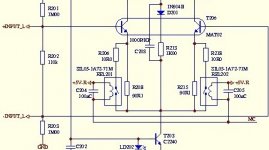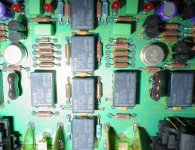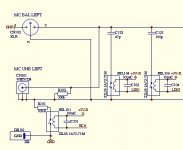i think now i understand, it´s your motto ! the circuit looks cool, is that controlling varios conditions of the circuit by remote controlled relay?
i think it is a bit philosophical what circuit is alowed to pride himself as balanced. you could argue that sending the same information, one with reversed phase over the same line is as good as sending the information in two parts on seperate lines with the same groud reference that are out of phase.
Gentlemen:
A balanced signal source does NOT have a center-tap. A floating source ( coil ) does
the job all by itselve. There is NO reference to ground. Ground can be used as a third
wire ( mostly the shield of a 2 signal-wire cable ) to connect the housing of the signal-source. ( body of a microphone or headshell of a turntable-arm )
The 3dB more noise occurs at the moment you connect a balanced source to a differential amplifier. When, for example your pre-amplifier has a transformer as an input,
secondary connected to a "usual" amplifier you have the most ideal balanced connection
that does not ad 3dB noise.
This technique is as easy as when you put a pair of batteries in your torch and switch
it on it will work.
Don't need to connect one end or even the centre of the two batteries to ground.
This technique is common in professional audio environments like theatre, recording and broadcast studio's where, due to the consequent use of this, even a
nearby GSM phone will cause no interference.
A balanced signal source does NOT have a center-tap. A floating source ( coil ) does
the job all by itselve. There is NO reference to ground. Ground can be used as a third
wire ( mostly the shield of a 2 signal-wire cable ) to connect the housing of the signal-source. ( body of a microphone or headshell of a turntable-arm )
The 3dB more noise occurs at the moment you connect a balanced source to a differential amplifier. When, for example your pre-amplifier has a transformer as an input,
secondary connected to a "usual" amplifier you have the most ideal balanced connection
that does not ad 3dB noise.
This technique is as easy as when you put a pair of batteries in your torch and switch
it on it will work.
Don't need to connect one end or even the centre of the two batteries to ground.
This technique is common in professional audio environments like theatre, recording and broadcast studio's where, due to the consequent use of this, even a
nearby GSM phone will cause no interference.
ok, i give up. just wanted to mention that in that Analog Devices PDF they gave a definition of truly balanced vs pseudo balanced i did not find somwhere else so i trusted that information to be folmally correct. it certaily helped me to solve a noise problem in my headamp.
relay?
It's the 1st development stage of a commercial balanced phono stage, the relay switches between MC/MM gain setting.
The final version has two separate stages for moving coil and MM, the rest of the circuit with RIAA and output stage is also balanced.
(and every thinkable item remotely switched by a few dozen relays.
 )
)
Last edited:
i hope the convenience factor is high and it is easy to use when you go the trouble of many options.
Gentlemen:
A balanced signal source does NOT have a center-tap. A floating source ( coil ) does
the job all by itselve. There is NO reference to ground.
THANK YOU for that! I have no end of resistance trying to get many people to believe that.
If you do the circuit analysis on a '3 pin' source, such as a hypothetical cartridge with a centre tap, you find that absolutely ZERO current flows in the centre conductor; hence it can be cut with no effect on the circuit operation.
So too with balanced dynamic microphones; they have no centre tap on the voice coil.
Exactly the same principle applies to 3-phase AC power distribution. You only need 3 wires, the star-point wire carries no current and can be cut (as long as the load remains balanced).
One problem that CAN arise, is that some manufacturers tie the cartridge body to one of the signal pins (L-). This unbalances the source - noise picked up by the cartridge body is injected asymmetrically into the signal conductors.
I think (but I could be wrong) the "psuedo part refers to the input stage ballancing. There are a number of opamp topologies that try to imitate the "perfect" ballancing of a transformer input, the pseudo ones arent as close, especially when the source becomes unbalanced.
Jensen Transformer's web site has good info on this subject.
Jensen Transformer's web site has good info on this subject.
Last edited:
convenience factor
If you use two turntables, one with MM cartridge and the other with an MC one, it is.
All settings are kept stored in the last position, also when mains is switched on/off, and swapping between MM input or the MC source doesn't require resetting.
The entire chain that's used with this phono preamp is balanced up to the power amp output as well, to get the most out of balanced operation.
A picture of the moving coil input stage section (the section for MM has dual matched JFET inputs)=>
Attachments
Then, to use the balanced input of a phono preamp, you connect the signal lines to the positive and negative inputs of the balanced socket, leave the ground open. Right?
What is the benefit?
What is the benefit?
Balanced cables are usually not coax but have 2 conductors and a shield. You connect the shield to ground at one end.
The advantages to balanced are noise rejection (but only noise picked up by the interconect cable) so rather limited, but more importantly, a lot easier to get rid of ground loops and ground noise, because the ground is not part of your signal carrier. So if you dont have a noise problem ( RF or 60 hz ground hum ) balancing the input wont make any difference.
The advantages to balanced are noise rejection (but only noise picked up by the interconect cable) so rather limited, but more importantly, a lot easier to get rid of ground loops and ground noise, because the ground is not part of your signal carrier. So if you dont have a noise problem ( RF or 60 hz ground hum ) balancing the input wont make any difference.
Last edited:
A picture of the moving coil input stage section (the section for MM has dual matched JFET inputs)=>
Looking at all the relays, cheap connectors and Oscons the designer does not appear to suffer from audiophilia nevrosa 🙂
Why solder a dozen or so Furutechs/WBTs on a dual input/output development board if 3 Dollar Neutriks are gold-plated too.
Of course, even an upmarket design doesn't have a chance in H to be bought by an audio-pile if it doesn't have $50 minimum each inputs to show or weighs less than 30lbs.
As this thread is not about input material but 2- or 3-pin, a fully balanced phono stage/input also makes it possible to have a floating RIAA correction.
Nice to see No-Nick name André Schmeets re-emerge in the DIY zone again. (he lives so far down south that he crosses the Belgium border each time he steps out of bed )
)
Of course, even an upmarket design doesn't have a chance in H to be bought by an audio-pile if it doesn't have $50 minimum each inputs to show or weighs less than 30lbs.
As this thread is not about input material but 2- or 3-pin, a fully balanced phono stage/input also makes it possible to have a floating RIAA correction.
Nice to see No-Nick name André Schmeets re-emerge in the DIY zone again. (he lives so far down south that he crosses the Belgium border each time he steps out of bed
 )
)Attachments
Last edited:
Cought !
yes it's me.
Well you know, i have been into broadcast-audio, using balanced audioconnections
exclusively for the last 20 years. Also designing apparatus that uses balanced in
and outs.
And i feel kind off responsible for any high-ender who wants to use a balanced connection.
Have been reading from time to time. This post triggered me. I will contribute more.
yes it's me.
Well you know, i have been into broadcast-audio, using balanced audioconnections
exclusively for the last 20 years. Also designing apparatus that uses balanced in
and outs.
And i feel kind off responsible for any high-ender who wants to use a balanced connection.
Have been reading from time to time. This post triggered me. I will contribute more.
- Status
- Not open for further replies.
- Home
- Source & Line
- Analogue Source
- Why balance input for phono amp?



